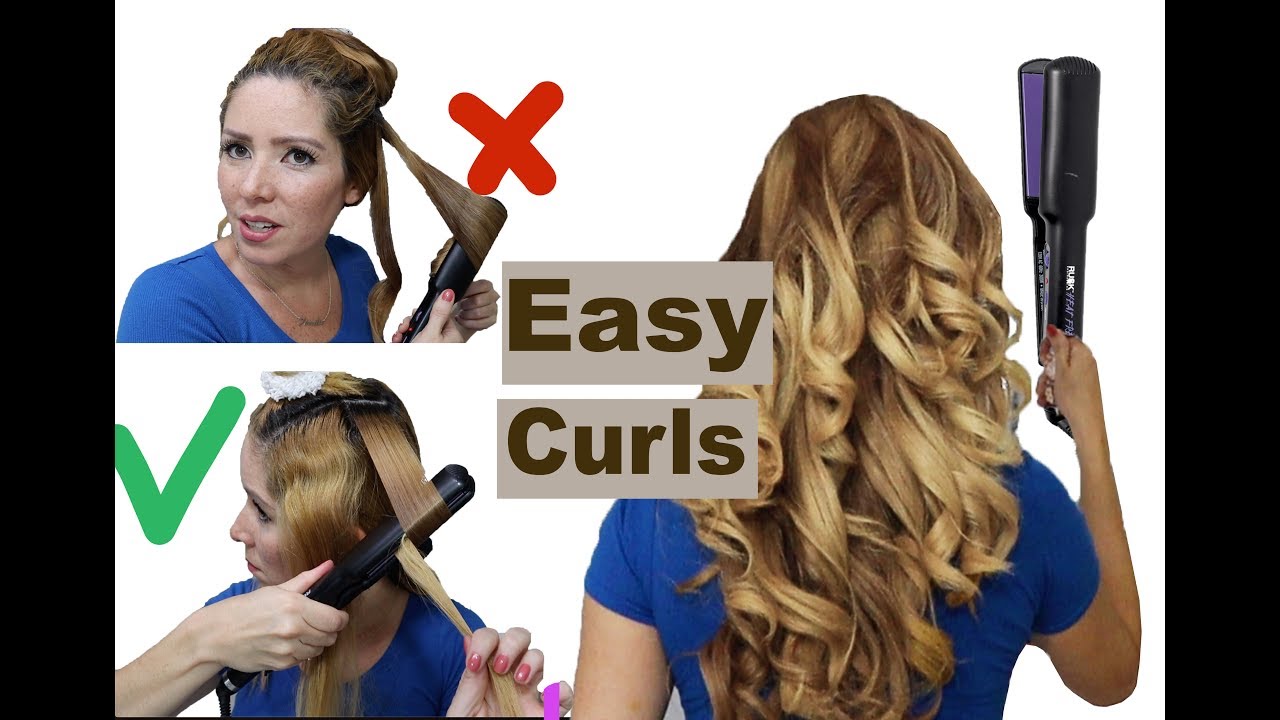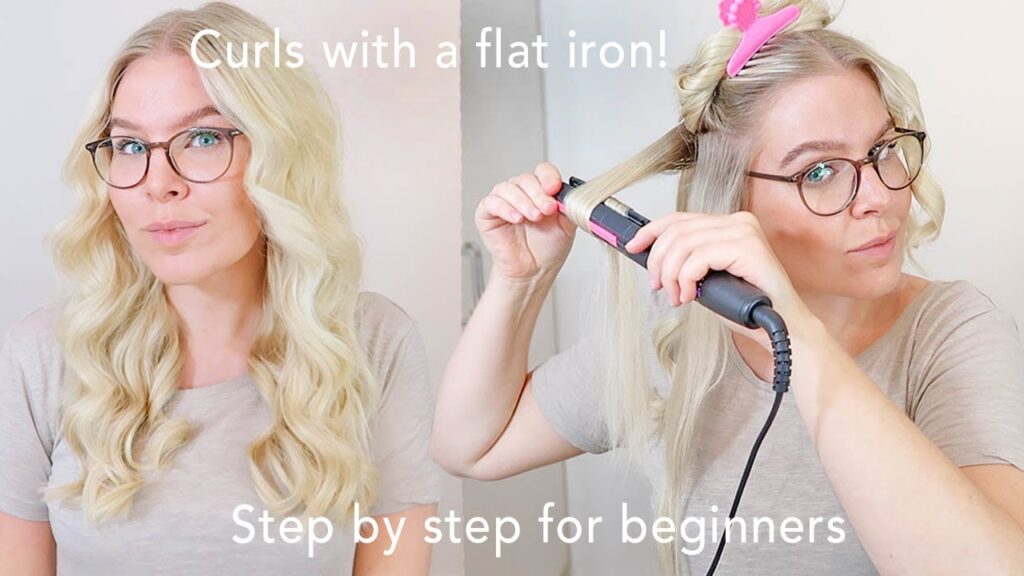For years, curling irons have reigned supreme in the world of hairstyling, offering a seemingly straightforward path to bouncy curls and glamorous waves. However, the versatility of a flat iron, often overlooked in the pursuit of perfectly formed curls, presents a surprisingly effective and adaptable alternative. This comprehensive guide delves into the art of curling hair with a straightener, revealing techniques that range from simple beach waves to tight, defined ringlets. The ability to achieve various curl types with a single tool not only offers convenience but also opens up a world of styling possibilities, perfect for those seeking both versatility and efficiency in their hair care routines. Whether you’re a seasoned stylist or a complete beginner, mastering this technique empowers you to create a range of looks, saving you time and money in the long run. We’ll explore the different techniques, hair types, and tools to help you achieve your desired curls effortlessly and safely, while addressing potential challenges and offering expert tips to ensure perfect results every time. From understanding the importance of heat protection to mastering the various wrapping techniques, this guide provides a complete roadmap to successfully curling your hair with a straightener, transforming your everyday styling routine.
Understanding Your Hair Type and Straightener
Before embarking on your curling journey, it’s crucial to understand your hair type and choose the right tools. Different hair textures require different approaches and heat settings. Fine hair, for instance, is more susceptible to heat damage and may require lower temperatures and fewer passes. Thick, coarse hair, on the other hand, often needs higher heat and more passes to achieve the desired curl. Your straightener’s plate size and material also play a significant role. Smaller plates are better for tighter curls and detailed work, while larger plates are ideal for creating looser waves and covering more surface area quickly. Ceramic plates generally distribute heat more evenly, reducing the risk of hot spots and minimizing damage. Understanding these factors ensures you tailor your technique to your hair’s specific needs, maximizing results while minimizing potential damage.

Choosing the Right Straightener
The selection of your straightener is paramount. Look for features like adjustable temperature settings, allowing you to customize the heat based on your hair type. Ceramic or tourmaline plates are generally preferred for even heat distribution and reduced damage. Consider the plate size; narrower plates offer more precision for intricate curls, while wider plates are faster for larger waves. Investing in a high-quality straightener with these features is a worthwhile investment in the health and beauty of your hair.
Plate Material Matters
Ceramic plates are widely considered the best option for even heat distribution, minimizing hot spots that can damage your hair. Tourmaline plates, often combined with ceramic, add an ionic feature that helps reduce frizz and static. Avoid metal plates, as they tend to distribute heat unevenly and can cause more damage. Always check reviews and compare different models to find the best straightener for your budget and hair type.
Essential Preparation: Protecting Your Hair
Protecting your hair from heat damage is crucial when using any heated styling tool. Before you even begin curling, apply a heat protectant spray or serum. These products create a barrier between your hair and the heat, reducing the risk of damage and breakage. Ensure your hair is completely dry before using the straightener; applying heat to wet hair can lead to significant damage. Begin with detangled hair, as knots and tangles can be pulled and broken during the curling process. Proper preparation is key to achieving beautiful curls without compromising the health of your hair.
Heat Protectant Products: A Must-Have
The market offers a wide array of heat protectant sprays, serums, and creams. These products contain ingredients that help shield your hair from high temperatures, preventing damage and breakage. Choose a product that suits your hair type and styling needs. Always follow the product instructions carefully for optimal results.
Sectioning Your Hair for Efficiency
Divide your hair into manageable sections before you begin curling. This ensures that each strand receives even heat and that you don’t miss any areas. Use clips to keep the sections separated, making the process smoother and more efficient. Proper sectioning is key to achieving consistent, well-defined curls.
Mastering the Techniques: From Waves to Ringlets
There are several techniques for curling hair with a straightener, each yielding different results. The basic technique involves clamping a small section of hair near the roots, twisting the straightener halfway, and slowly gliding it down the length of the hair. The angle and speed of the glide determine the curl’s tightness. For looser waves, use larger sections of hair and a slower glide. For tighter curls, use smaller sections and a faster glide. Experiment with different techniques to find what works best for your hair type and desired style. Practice makes perfect – don’t be discouraged if your first attempts aren’t flawless.
Creating Loose Beach Waves
For a relaxed, beachy look, use larger sections of hair and a slower, more gentle gliding motion. Instead of twisting the straightener completely, slightly rotate it as you move it down the hair shaft. This technique creates a natural, tousled wave that’s perfect for everyday wear. This is a great technique for beginners as it’s less precise and more forgiving.
Achieving Tight, Defined Ringlets
To achieve tight ringlets, use smaller sections of hair and a faster, more controlled gliding motion. Twist the straightener completely as you move it down the hair shaft, ensuring a consistent twist for even curls. This technique requires more practice but yields beautifully defined ringlets. This technique is best suited for those with some experience using a straightener.
| Curl Type | Hair Section Size | Straightener Glide Speed | Twisting Motion |
|---|---|---|---|
| Loose Waves | Large | Slow | Slight rotation |
| Defined Curls | Medium | Medium | Complete twist |
| Tight Ringlets | Small | Fast | Complete twist |
Troubleshooting and Common Mistakes
Even with careful preparation and technique, challenges can arise. One common issue is uneven curls, often caused by inconsistent sectioning or varying heat application. Another common problem is hair breakage, usually due to excessive heat or using the straightener on wet hair. Understanding these common issues helps prevent them and achieve better results.
Uneven Curls: Identifying and Fixing the Problem
Uneven curls often stem from inconsistent sectioning or uneven heat application. Ensure you divide your hair into equally sized sections and apply the heat consistently to each section. Use heat-resistant clips to keep the sections separated and prevent accidental straightening. Practice and patience are key to achieving consistent curls.
Hair Breakage: Prevention and Solutions
Using too much heat or applying heat to damp hair is the primary cause of hair breakage. Always use a heat protectant spray and ensure your hair is completely dry before using the straightener. Avoid holding the straightener in one place for too long and use a lower heat setting if necessary. Prioritizing hair health is essential for long-term beauty.
Maintaining Your Curls and Long-Term Hair Health
Once you’ve achieved your desired curls, it’s important to maintain them and protect your hair’s health. Avoid touching your hair excessively, as this can disrupt the curls and cause frizz. Use a light-hold hairspray to set the curls and maintain their shape throughout the day. Regularly deep condition your hair to replenish moisture and prevent dryness and damage. Long-term hair health requires a holistic approach, including proper styling techniques and regular hair care.
Setting Your Curls with Hairspray
A light-hold hairspray can help set your curls and prevent them from falling flat. Apply the hairspray gently from a distance, avoiding weighing down the curls. Avoid using too much hairspray, as this can make your hair look stiff and unnatural.
Deep Conditioning for Healthy Hair
Regular deep conditioning treatments help replenish moisture and repair damage caused by heat styling. Use a deep conditioner once or twice a week, depending on your hair type and needs. Healthy hair is more resilient and less prone to damage.
Summary
Curling hair with a straightener offers a versatile and efficient way to achieve various styles, from loose waves to tight ringlets. Success hinges on understanding your hair type, choosing the right tools, and mastering the proper techniques. Preparation is key: use a heat protectant, ensure your hair is dry, and section it effectively. Different techniques produce different results; experiment to find what suits you best. Troubleshooting common issues like uneven curls and breakage involves addressing inconsistent heat application and using appropriate heat settings. Finally, maintaining your curls and prioritizing hair health through hairspray and regular deep conditioning ensures long-lasting results and beautiful, healthy hair. Remember, practice and patience are key to mastering this versatile styling technique.
- Choose the right straightener for your hair type and desired style.
- Always use a heat protectant to minimize damage.
- Section your hair for even heat distribution.
- Master different techniques to achieve various curl types.
- Address common issues such as uneven curls and breakage.
- Maintain your curls and prioritize hair health.
Frequently Asked Questions (FAQs)
Can I curl my hair with a straightener every day?
While possible, daily use of a straightener can damage your hair. It’s recommended to limit its use to a few times a week to minimize heat exposure. On days you don’t use the straightener, opt for gentler styling methods or let your hair air dry naturally.
What temperature should I use on my straightener?
The ideal temperature depends on your hair type. Fine hair requires lower temperatures (around 250-300°F), while thick, coarse hair may tolerate higher temperatures (up to 400°F). Always start with a lower temperature and gradually increase it if needed. Never exceed your straightener’s recommended maximum temperature.
How long should I hold the straightener on each section of hair?
Avoid holding the straightener on any one section for more than a few seconds. Excessive heat can damage your hair. The key is to use a quick, controlled motion to create the curl. If you need more definition, repeat the process, but never linger in one spot.
What type of hairspray is best for setting curls created with a straightener?
A light-hold hairspray is generally recommended to avoid stiffness and weighing down your curls. Look for a hairspray that offers hold without causing build-up or stickiness. Apply it gently from a distance to maintain a natural look.
What should I do if my curls fall flat quickly?
If your curls fall flat quickly, it could be due to several factors, including the type of hairspray used, the health of your hair, or the technique employed. Try using a stronger hold hairspray, ensure your hair is completely dry before curling, and consider using smaller sections of hair for tighter curls. Also, make sure your hair is healthy and hydrated through regular conditioning.



